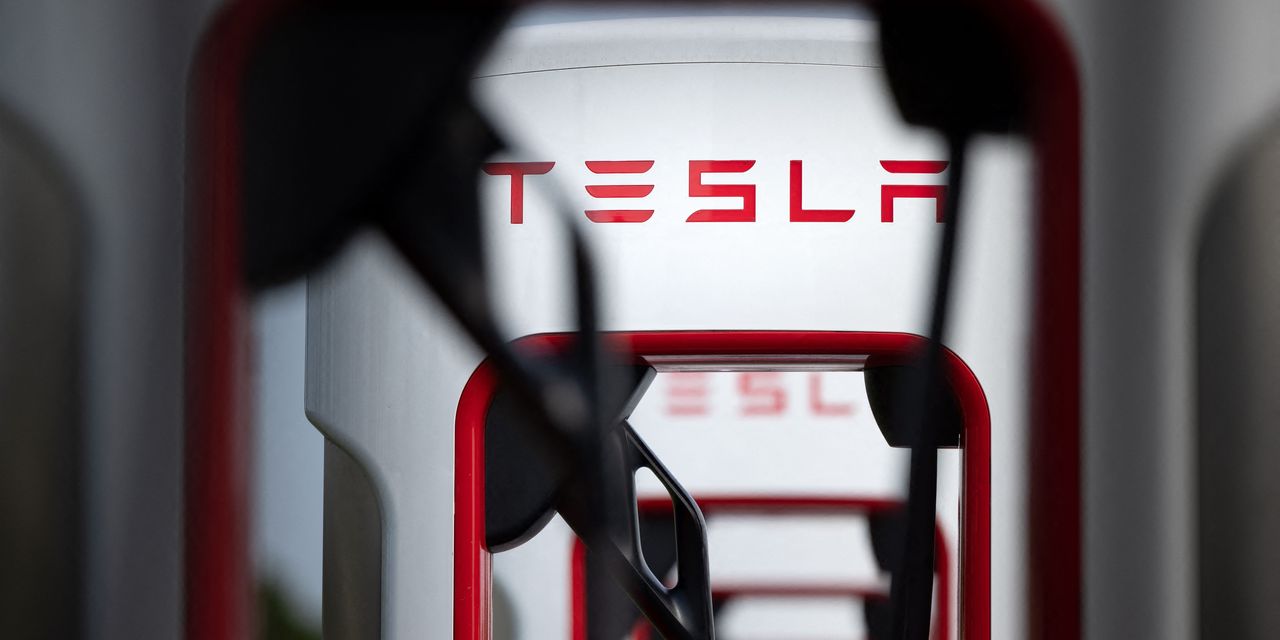Production, sales, interest rate hikes, bankruptcy, disruption, deals between warring factions… For car investors, the second quarter had a little of everything.
It’s exciting. Taking a step back shows a few things that investors should remember from the past three months and unveils a few stocks that can work in the second half of the year. One of the stocks could be
Tesla
(ticker: TSLA).
Tesla Is Tough to Catch
The first lesson of Q2: The strong are getting stronger. While the complete set of numbers won’t be available for a few days, Q2 was likely another record for EV sales in America, up roughly 10% compared with the first quarter of 2023.
It isn’t easy to ride the wave of rising EV sales to riches though. The second quarter claimed an early EV startup.
Lordstown Motors
(ticker: RIDEQ) filed for bankruptcy protection in June. It had trouble building electric pickup trucks and finding enough cash to keep building them.
Tesla
is the one benefiting most from rising sales. In the first and second quarters of 2023, Tesla increased U.S. market share relative to
Ford Motor
(F),
General Motors
(GM), and
Rivian Automotive
(RIVN, three U.S. companies vying for Tesla’s EV crown.
It’s an impressive feat. No one really expects Tesla’s U.S. share to stay in the 60%-plus range. Bullish Tesla investors would be pleased with 20%. The largest automakers in the world,
Toyota Motor
(TM) and
Volkswagen
(VOW. Germany), each have roughly 10% of the global market for light vehicles.
EVs Aren’t Expensive Anymore
Tesla’s significant price cuts early in 2023 helped the company capture more share. The cuts have also made EVs pretty economical.
EVs were once considered luxury vehicles. But with price cuts and tax credits, a lot of EVs are cheaper to purchase than gasoline-powered cars.
Take the top-selling long-range Model Y. It starts at about $50,500. That’s roughly $2,000 more than the price of an average new car in the U.S. Still more expensive, but the price premium used to be about $10,000.
Then there is the $7,500 federal tax credit to consider. That makes the long-range Model Y about $5,500 less expensive than the average new car purchased in the U.S.
A Tesla Model 3 is less than the Y. The Chevy Bolt is less than the Model 3. There are plenty of affordable EVs for car buyers these days.
$1,000? Ouch.
Affordable is good since consumers are stretched. The percentage of new car buyers that finance vehicles paying more than $1,000 a month for their car hit another record in Q2. More than 17% are laying out four figures a month.
That’s the equivalent to roughly 25% of pretax monthly wages for the average 25- to 34-year-old. (The average person in that age range might not be able to afford a new car.)
The combination of rising interest rates and rising new car prices are the reason for the record. Car prices are coming down and interest rates might not go up much more.
That would be good news for car buyers. They would welcome some relief.
Few Cars
It’s worth asking how consumers are handling higher payments. The answer is some aren’t.
Cars just aren’t selling like they used to. Annual light vehicle sales are roughly 1 million to 2 million units lower than prepandemic levels. That’s a drop of roughly 10%. Some people have been priced out of the new car market.
Sales are rising though. Q2 sales were up about 2% relative to Q1 and up about 9% compared with Q4.
More sales volume is a big benefit to suppliers. They sell parts to automakers and care more about total sales than the final price of a sale to customers. Automakers care about both those things.
Rising sales is a reason BofA Securities analyst John Murphy upgraded several auto supplier stocks this past week. He raised shares of
BorgWarner
(BWA),
Magna International
(MGA), and
Aptiv
(APTV) to Buy from Hold. Those are three stocks investors can check out for the second half of 2023.
A New Standard
One of the most unexpected Q2 developments was a plug. Everyone, it turns out, will adopt the Tesla EV charging plug in North America.
It isn’t officially everyone, but it might as well be. GM, Ford, Rivian,
Polestar Automotive
(PSNY), Volvo, and
Mercedes-Benz
(
MBG.
Germany) all announced they will use the Tesla plug.
The reasons are easy to see. One plug is better than multiple plugs. (No one would accept the need for an adapter to plug in a lamp from IKEA.) And Tesla has the most EVs on the road, the most charging stations, and its plug is a lot smaller than the competing plug called a CCS plug. It’s easier to handle.
Moving to one standard is a win-win-win. Tesla obviously wins. It gets revenue from non-Tesla EV drivers. Non-Tesla drivers also get exposed to the scope and reliability of the Tesla charging network.
Other automakers win. Their customers get access to the largest network of fast chargers, making it easier to sell their EVs.
And the EV industry wins too, because charging infrastructure is a big deal. More chargers ease range anxiety, a key concern of potential EV buyers. And it makes life so much easier for the industry. Imagine if drivers had to consider the shape of the gas pump before pulling into an
Exxon
station when nearing empty.
The deals with automakers helped Tesla to one of its best starts to a year. Shares gained 113% in the first half of 2023 while the
S&P 500
and
Nasdaq Composite
added about 16% and 32%, respectively. Shares have gained more than 100% in the first half of two other years, 2013 and 2020. In 2013, Tesla shares gained about 40% in the second half. In 2020, Tesla shares gained about 230% in the second half of the year.
Write to Al Root at [email protected]
Read the full article here













